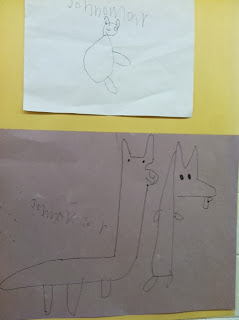 |
| A little person sitting on a pumpkin. |
The following pieces go along with this dialogue:
Me- You made your gourd and then you turned it into something else. Tell me about it.
E- We made a castle!
N- We like to make castles. There's a kitchen and a pool.
E- A big pool!
N- A deep pool.
E- And a baby pool.
N- There's a bounce house, too!
Mrs. L- Who lives there?
E- Us! And our families!
N- And all of our friends here at school. Now it looks like a Bridge Castle.
E- It's for a bird.
N- We have pets in our house.
Mrs. L- What do you call this castle?
E- The Family Castle
N- The Bridge Castle. The bridge castle is in the backyard of the Family Castle. This is the backyard.
E- This is the bird.
Mrs. L- How do you get upstairs?
E- We climb here.
N- and there's a shower!
 |
| The Family Castle |
 |
| Another view of the family castle. |
 |
| "The Bridge Castle is in the back of the family castle." |
 |
| A camera. I assume this was inspired by all of the photos I was taking. |
116 bilingual second grade students had a test this period, so I proctored the exam.
108 monolingual first grade. I took another small group to work on their community in clay. We have a practice map to place the buildings on and I'm finding that even the most rough looking buildings are working when they are all placed on the map. I can't wait to see the completed community. I'm happy to let them take the time to explore the clay and try to perfect their important buildings, though I'm really looking forward to seeing them fired and assembled.
112 self-contained class. We worked on our globes. I think these will be finished after one more class. The globes look cool, but they lack the excitement of our shell exploration and I'm trying to put my finger on the reason. I think it's because the globe can only look one way and there's not a lot of freedom of expression.
103 preschool- Students added "beautiful stuff" to their murals. We'll spend the next class critiquing the murals through storytelling. I want to give them a chance to describe what they made and what it means, then hear each other and try to tie it together to make a mural story. If they wish to add more to the murals after this discussion, we can do that.
Details of our "beautiful stuff" added to the murals.
104, bilingual kindergarten- We had a really awesome, unexpected opportunity. As I walked through the building, I heard someone say that there were llamas outside. I thought they were joking, but a few minutes later, another class was heading out to see the llamas. I followed them and, to my surprise, there were two llamas in our playground area.
The owners had been at a school near ours and stopped by to see if we would like a visit with llamas, as well. The llamas ended up in our courtyard and the kindergarten class went to see them. I ran to get pens and paper. The students drew the llamas from life!
They came into the studio and we had a dialogue to recall the details of our llamas.
The students are numbered.
Mrs. Rose- So we had something unusual happen today. What was it?
Student 1- We saw the llamas. That was different.
Student 5- A black and white one.
Mrs. Rose- Tell me about the llamas.
Student 7- They were big.
Student 6- The neck is really high.
Student 2- And the neck is like a rectangle.
Student 6- The face is like a circle.
Student 1- More like a rectangle. The neck was so big.
Student 6- The ears were like a triangle, like this.
Student 7- On top of the head.
Student 2- There were two ears.
Mrs. Rose- can you tell me any other details about them?
Student 8- They have long feet with two toes.
Student 7- They eat.
Student 6- They eat grass.
Student 8- I saw them eat grass. It was so beautiful. Do they have
babies?
Student 6- I think yes.
Student 2- They are in the tummies
Student 7- Like we were in the tummies of our moms
Student 8- And my brother was in my moms tummy
Mrs. Rose- Do you have any questions about the llamas?
Student 2- The llamas eat like this (chews sideways with his mouth)
Student 1- The llamas have a tummy like this. (puffs out her belly.)
Student 6- A circle tummy, too.
Student 7- Where do they live?
Student 8- They live on the farm, on the grass, outside.
Student 7- No, they do not! I think they live somewhere hot. I know this
because I saw a movie.
After we had our discussion, I put the photos I'd taken of the llamas on the smartboard and asked the students if they'd like to try to draw the llamas again, to see if they could improve upon their initial sketches. They were eager to do this and the results show much more attention to detail.
Their homeroom teacher said the class saw a llama in a book yesterday and they were so excited because they have a greater awareness of this animal now. :)





















.JPG)
.JPG)




No comments:
Post a Comment